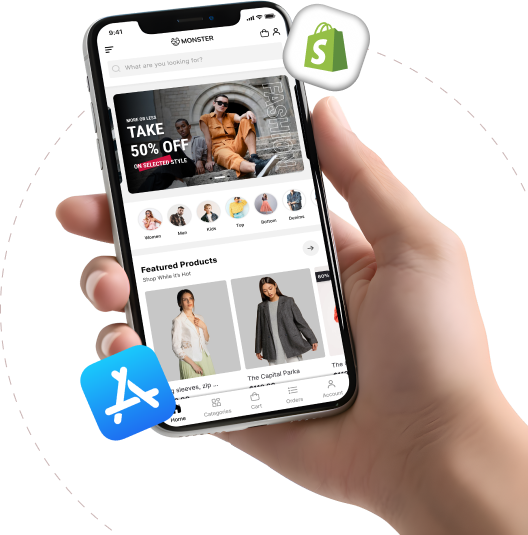Table of Contents
- Introduction
- Shopify Strategies for Optimal Performance in Your Shopify Store
- Optimize Your Website Design and User Experience
- Add SEO Best Practices
- Offer Attractive Deals and Promotions
- Utilize Social Proof and Customer Reviews
- Optimize your Checkout Process
- Personalize the Shopping Experience
- Optimize for Mobile Conversion
- Invest in Paid Advertising
- Optimize Product Pages for Conversions
- Track and Analyze
- Summing Up
Amidst the burgeoning sea of online enterprises clamoring for consumer attention, the adoption of potent strategies becomes imperative to carve a distinctive presence and allure customers. This blog post delves into time-tested tactics and methodologies aimed at fine-tuning your Shopify store sales for conversions.
Shopify Strategies for Optimal Performance in Your Shopify Store
1. Optimize Your Website Design and User Experience:
To optimize your Shopify store’s design and user experience, prioritize a clean, intuitive layout with effortless navigation. Use HD and high-quality images and effective product descriptions to effectively Showcase your offerings. Another important Shopify Sales strategy is to ensure swift loading times and mobile responsiveness to cater the rising number of mobile Shoppers. Streamline the checkout process to maximize conversions.
Also, implement Clear calls to action strategically throughout the website to guide and conduct visitors towards making a purchase decision. Also, try to analyze and leverage customer reviews and testimonials to develop credibility and trust. This ensures to increase in Shopify conversions.
In addition, continuously analyze and monitor user behavior to identify factors and areas for improvement and investigate the user experience accordingly. By considering these vital key aspects, you can create an engaging and seamless online Shopping experience that encourages readers to become loyal clients.
2. Add SEO Best Practices:
SEO is one of the main factors for boosting traffic, which helps you to increase your Shopify store sales. In addition, if you are looking to increase Shopify conversions, start with thorough keyword research and pinpoint relevant terms by incorporating titles, descriptions, product optimization, and meta tags.
Also, creating knowledgeable blog posts, product books, and guides not only educates but also enhances your website’s online visibility on SERPS (search engines). Therefore, utilize these Shopify store strategies, and you can also hire a Shopify SEO company to attract robust potential clients and improve ranking in search engine pages, thereby raising your store’s online presence and driving more genuine traffic to your products.
3. Offer Attractive Deals and Promotions:
Short-period sales lead to urgency in buying decisions, encouraging hesitant buyers to take action. All intensive discounts personalized for email subscribers not only reward trustworthiness but also promote a feeling of exclusivity to encourage more sign-ups. Free order Shipping incentives, especially for orders surpassing a particular threshold, convince clients by including additional costs and enhancing customer perceived value.
Shopify’s discount code feature leads businesses to create attractive offers seamlessly. Whether it; BOGO deals, percentage discounts, or freebies. This tool allows flexibility in promoting strategies to suit diverse marketing objectives. The placement of promotional call-to-action buttons and promotional buttons across the website increases online visibility and encourages client engagement.
4. Utilize Social Proof and Customer Reviews
Utilizing social proof through client testimonials and reviews is vital to instilling credibility and trust in potential clients. placing these endorsements on product pages leads to substantial evidence of your product’s reliability and quality, reassuring reluctant visitors and fostering informed buyers’ decisions.
Encouraging satisfied clients to give reviews can be rewarding for your Shopify store, boosting them to share their positive responses. This not only generates valuable reviews and feedback but also maximizes the volume of social profiles that will develop trustworthiness for prospective clients.
In addition, along with textual reviews, including user-generate content like videos and photos Showcasing clients enjoying your services, enriches the authoritativeness and authenticity of your business. Seeing real people benefiting from and rewarding your services resonates deeply with potential buying, building their interest and confidence in your business.
5. Optimize your Checkout Process:
An efficient checkout process can significantly affect your conversion rates. Eliminated any unnecessary friction points from the checkout flow to make it as easy and quick as possible for clients to complete their buying process.
Offer multiple payment options, including famous gateways like Apple Pay and PayPal, to accommodate different preferences.
Implement guest checkout functionality to allow first-time buyers to complete their purchase without creating an account. In addition to textual reviews, incorporating user-generated content like photos and videos showcasing customers enjoying your products enriches the authenticity of your brand. Seeing real people benefiting from and endorsing your offerings resonates deeply with potential buyers, reinforcing their confidence in your brand.
6. Personalize the Shopping Experience:
Customizing the client’s buyer journey is the strategic move that promotes deeper engagement and maximizes conversion rates. By employing data gleaners from browsing behavior, client locations, and past purchases, eCommerce businesses can provide personalized product recommendations, marketing messages, and email campaigns that resonate with individual interests and preferences.
You can target email automation that allows businesses to deliver customized messages depending on customer segments or specific triggers, driving repeat purchases, and nurturing relationships. Therefore, offering a personalized Shopping experience can always help to generate robust Shopify store sales.
7. Optimize for Mobile Conversion:
Interactive and responsive design is essential for mobile optimization, enabling your website to adapt to different orientations and sizes. Implement.
Executing easy-to-tap buttons and streamlined navigation simplifies checkout processes and web browsing, decreasing friction and enhancing user satisfaction.
Analyzing thorough testing across different screen resolutions and devices is crucial for dealing with hurdles that could lead to mobile conversion rates. This continual approach enables the purification and fine-tuning of the mobile experience, aligning it with user preferences and expectations.
Therefore, enhancing and optimizing form for mobile interface by reducing typing needs and using features like autofill accelerates the checkout process, resulting in minimizing rejection rates. In addition, to optimize your mobile app you can opt for the Shopify app development as this will help you to provide a hassle-free experience for your users.
8. Invest in Paid Advertising:
Paid advertisement investment presents a planned approach to drive organic traffic and expand your Shopify store reach. Google’s PPC (Pay-per-click) advertising platforms like Facebook Ads and Google Ads provide flexible tools for focusing on target audiences. This helps to drive relevant and genuine traffic to your services or products.
Targeting demography is another main factor of investing in paid advertising. This helps advertisers to analyze and monitor key demographic regions and their characteristics like location, gender, age, and interests, enabling that your advertisements are displayed to convert and engage specific audience.
Moreover, retargeting and readvertising campaigns can help eCommerce businesses reapply with users who have interacted and engaged with eCommerce websites or have shown interest in your products or services. In such case, generating tailored ads to these individuals, businesses can support leads and guide them further to convert into Sales.
9. Optimize Product Pages for Conversions:
Having interactive and visual product pages has the maximum percentage of converting sales. So, ensure that they are optimized in good manners. So, to boost Shopify Store sales, write compelling product titles and descriptions that highlight the benefits and unique selling points of each item.
Design and use HD images and videos to highlight your services and products from various views and offer as much information as possible to help clients make informed buying decisions. Also, you can opt for custom Shopify theme development services to create and design user-centric product pages.
Implement exact CTAs (call-to-actions) that help visitors add products to their shopping cart and seamlessly complete the checkout process.
10. Track and Analyze:
Monitor, track, and analyze key metrics that are vital for Shopify Store optimization and performance. You can utilize in-built analytics of Shopify, Google Analytics and other tracking tools to analyze and monitor metrics like website conversion rates, website traffic, average order value, and client lifetime value.
By analyzing this data, you can rectify trends, pinpoint areas for improvement, and make buying decisions to boost your sales funnel. Continuously analyzing and monitoring these measures enables you to implement Shopify sales strategies, optimize user experiences, and refine targeting which results in driving Shopify Store Sales higher.
Summing Up
By continuously implementing these strategies and adapting to client’s preferences and market trends, you can increase eCommerce sales and maximize conversions for your Shopify store. By enhancing customer feedback and data analytics, you will grasp valuable tactics and insights into your targeted client’s preferences and behavior. This allows you to personalize your strategies for increasing impact.


















